Back to Don's Maps
The Clan Cave
Photographs and text used by kind permission of Dr Ralph Solecki
The Clan Cave in the EC series is located on the Crimean Peninsula, but the original was excavated by Drs Ralph and Rose Solecki hundreds of kilometres away in Iraq.
Click on the photos to see an enlarged version
For some excellent photographs by Erik Trinkaus see:Modern Human Origins site
From Shanidar, by Dr Ralph Solecki
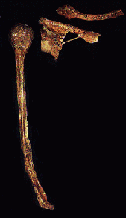 Shanidar 1's atrophied right arm, collar bone, and shoulder blade.
Shanidar 1's atrophied right arm, collar bone, and shoulder blade.
Photo: http://sapphire.indstate.edu/~ramanank/care.html
As we exposed the skeleton there was increasing confirmation that this individual had been killed on the spot by a rockfall. Bones were observed to be broken, sheared, and crushed in place. Some bones were in direct contact with the stones. Various parts of the skeleton had been crushed upon underlying stones of small size. The force of the stone fall seems to have been greatest on the individual's lower legs, his left hip, and the upper part of his chest. It was noted that the left shoulder was higher than the right, and the left hand and arm lay across the chest. Under field conditions the right hand and forearm could not be seen among the remains. Later, in Baghdad, T. Dale Stewart discovered that Shanidar I, a male, had an underdeveloped right shoulder blade, collar bone, and upper right arm bone. He believes that Shanidar I was crippled, with a useless right arm, which had been amputated in life just above the elbow. This discovery was something we had never anticipated in the field identification of the skeleton.
My reconstruction of this fatal accident is that the individual had been killed by a rockfall while he was standing on the sloping cave floor, possibly facing to the east. The fall of stones which struck him was a minor wave of a larger ceiling collapse towards the front of the cave. His body was not completely covered with stones, although the impact was forceful. Fortunately also for the preservation of the remains, the soil absorbed some of the blow. If the stones had been larger or if he had been caught against a solid bed of stones, his bones would have been crushed into an unrecognizable pulp. There would have been little left but a thin phosphate layer for the archaeologist to muse over.
A number of stones must have fallen on him within split seconds, throwing his body backwards full length down the slight slope. Presumably the first stones struck him on the head and across the feet and legs. In falling backwards, his body twisted to the right, pinning down his useless stump of a right arm. His left arm and hand, drawn protectively to his chest, were crushed into his ribs and spine. At the same time, a block of stone severed his head and neck from his trunk, and left them in an unnatural attitude. The lower jaw was dislocated to the front and left side of the cranium and broken against a flat stone. There were a couple of small concentrations of mammal bones in association with the skeleton which might have been rodent nests. But it is equally possible that, these bones were dropped there as part of a funeral feast for the dead.
I believe that the survivors of the rockfall returned, and seeing what had happened, heaped some loose stones, the closest at hand, over the unfortunate's remains. Some of the loose mammal bones lying on top of and among these stones may have been part of the funeral feast. Eventually, a few inches of occupational deposits accumulated over the heap, followed by another rockfall, which sealed off the Mousterian deposit in this quarter. Thus ended a people and an age at Shanidar Cave.
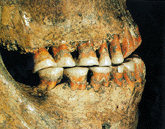 Part of Shanidar 1's skull, showing the unusual wear on his front teeth
Part of Shanidar 1's skull, showing the unusual wear on his front teeth
Photo: http://sapphire.indstate.edu/~ramanank/care.html
Although he was born into a savage and brutal environment, Shanidar I man provides proof that his people were not lacking in compassion. According to Stewart's findings, he was an individual who lived to the relatively old age of forty years, a spry old man for a Neanderthal - equivalent to a man of about eighty today. He was plagued by arthritis, which seems to have been a rather common ailment among Neanderthals - and no wonder, considering the kind of life they led. As a case of rehabilitation, Shanidar I was a prime example. Not only did he possess a disability from the day he was born, but he must have been blind in the left eye. Stewart's examinations disclosed that the right arm, collar bone, and shoulder blade had never fully grown from birth. Furthermore, there was extensive bone scar tissue on the left side of his face. And as if this were not enough, there is evidence that the top right side of his skull had received some damage which had healed well before the time of death. In short, Shanidar I - or 'Nandy', as we called him around the dinner-table - was at a distinct disadvantage in an environment where even men in the best of condition had a hard time. He could barely forage and fend for himself, and we must assume that he was accepted and supported by his people up to the day he died. Any manpower must have been an asset to this ancient little community, especially since it undoubtedly took group activity to hunt the gregarious beasts of the wild. That 'Nandy' made himself useful around the hearth (two hearths were found very close to him) is evidenced by the unusual wear on his front teeth. It presumably indicates that in lieu of a right arm, he used his jaws for grasping, while manipulating with his good left arm and hand.
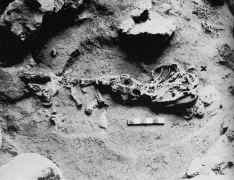
Skeleton of Shanidar I, the inspiration for Creb in the Jean Auel series.
The head was removed first because of the danger of damage while getting at the rest of the skeleton, which involved blasting. The original position of the head is shown with an X. The photo was apparently printed back to front in the text. I have flipped it to agree with the published drawing below.
Photo: Dr Ralph Solecki
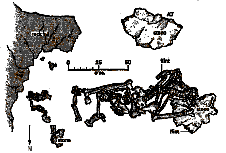
Drawing of the skeleton of Shanidar I, the inspiration for Creb in the Jean Auel series.
The head was removed first because of the danger of damage while getting at the rest of the skeleton, which involved blasting.
Photo: Dr Ralph Solecki
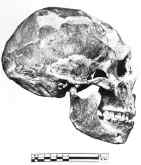
Restored skull of Shanidar I, the inspiration for Creb in the Jean Auel series.
Restored by T. Dale Stewart
Photo: Dr Ralph Solecki
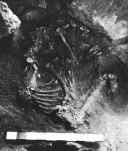
Photograph of Shanidar IV, the inspiration for Iza in the Jean Auel series. The (male) skeleton was found buried with many different species of flowers and herbs, evidenced by pollen remains. He was laid to rest sometime between late May to early July. There were at least eight different species of flowers, mainly small brightly coloured wild flowers. There were relatives of the grape hyacinth, bachelor's buttons, hollyhock, and a yellow flowering groundsel. The flowers were probably woven into a pinelike shrub. The most numerous of the flowers were: members of the daisy family, the yarrow or milfoil, St Barnaby's thistle, groundsel, grape hyacinth, joint pine or woody horse tail, hollyhocks. Photo: Dr Ralph Solecki
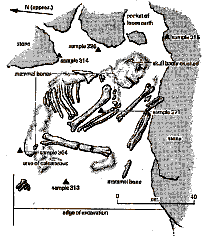
Sketch of Shanidar IV, the inspiration for Iza in the Jean Auel series.
Photo: Dr Ralph Solecki
However, see the following which casts doubt on the flower burial theory:
DOUBT THROWN ON RITUALISTIC NEANDERTAL BURIAL
See Physical Anthropology, 7th edition, Chapter 14, pages 368-369.
Many investigators of Neandertal culture believe that the Neandertals were the earliest hominids to ritually bury their dead. Important evidence that supports this conclusion comes from Shanidar Cave, located in the Zagros Mountains of northern Iraq. Ralph Solecki excavated Shanidar Cave between 1951 and 1960. He recovered Mousterian tools and seven adult and one child burial from Level D. While four of these individuals appear to have been killed by rockfalls, four others may have been deliberately buried.
Soil samples taken around the burial known as Shanidar IV revealed the presence of pollen grains and bits of vegetable matter. While there was very little pollen in most of the soil samples taken around the skeleton, two samples from the burial itself contained a large number of pollen grains representing 28 plant species. This evidence was used to support the hypothesis that more than 50,000 years ago the body was deliberately and ritualistically buried on a bed of woody branches and flowers sometime during the months of May through July, when the flowers were in bloom. The flowers included yarrow, groundsels, grape hyacinth, and St. Barnaby's thistle.
Not everyone has accepted this conclusion, however. The original report reported the existence of rodent holes around the burial along with the remains of rodents of species Meriones persicus or the Persian jird. These animals live in large colonies, and they are known to store large amount of seeds and flowers in their burrows. Analysis of jird burrows has revealed the presence of many of the same flowers that were found around Shanidar IV. Thus the presence of flower pollen around the skeleton may not have been the result of ritualistic activity, but simply the establishment of jird burrows following the burial.
Source: J.D. Sommer, "The Shanidar IV 'Flower Burial': A Reevaluation of Neanderthal Burial Ritual," Cambridge Archaeological Journal, 9 (1999), 127-129.